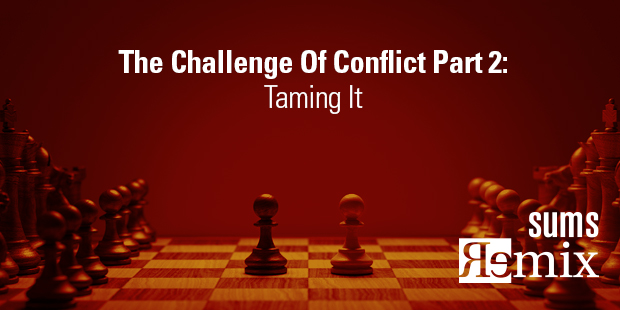
The Challenge of Conflict, Part Two: Taming It
How do you handle church conflict?
No matter how you define it, conflict is a serious issue that all church leaders face – all too often. You would think that a church “family” should be able to avoid conflict. But how often does your own biological family go through conflict of various intensities?
Your church family consists of hundreds or thousands of complex human relationships, all brought together under the banner of worshipping and serving God in this particular place and time.
You’ve invested yourself heavily in these relationships – as has everyone else to varying degrees. We all have expectations of each other – and when those are not met, the seeds of conflict are planted. Left unaddressed these small seeds can grow into a garden of weeds that choke out the healthy dialog needed to restore the relationship. The longer the situation goes untended, the greater the issue(s) magnify – until the weeds have taken over the garden and any hope of bearing fruit has been squeezed out entirely.
Is it possible to avoid conflict entirely? In a word, no. We’re too “human” to hope for that.
Can we transform and redeem conflict from a destructive force to one in which all parties come through the other side, better for the experience? In a word, yes. We’re children of a loving Father, and His love can see us through any level of conflict.
THE QUICK SUMMARY – Discover Your Conflict Management Style, by Speed B. Leas
Speed B. Leas helps readers to assess their conflict response and discover options appropriate to different levels of conflict.
He draws on years of experience helping conflicted congregations to provide valuable insights on the nature of conflict and its resolution, making this an excellent tool for raising self-awareness and a practical introduction to conflict management.
This new edition contains an improved Conflict Strategy Instrument, revised to reflect new learnings and more accurately describe your conflict management style.
A SIMPLE SOLUTION
When faced with almost any situation in life, most of us will respond on the basis of how we have handled similar encounters. Our response pattern is also influenced by the issue at hand or the individuals involved. For example, an individual may find controlling the conversation during an argument works best with his spouse. That same pattern will usually be taken in similar conflicts with others.
This “conflict management style” may be intentionally or unintentionally selected. It may also change depending on the specific circumstances surrounding the conflict.
If you accept the principle that conflict is a part of life, and that, over time, we adopt specific conflict management styles, then the natural progression delivers this: Identifying and understanding our conflict management styles will usually help us work through conflicts in a quicker and more satisfactory conclusion for all parties involved.
Understanding your conflict management style will help you become more comfortable with differences and encourage open and confident sharing of differences and concerns with one another.
This instrument identifies six different styles for managing differences: Persuading, Compelling, Avoiding/Accommodating, Collaborating, Negotiating, and Supporting.
Each can be an appropriate style, and none should be thought of as “bad” or inferior. A certain style can cause a problem when it is used inappropriately, but one should not assume that Avoiding is always wrong or that all conflicts must be confronted.
Persuasion strategies are those where a person or group attempts to change another’s point of view, way of thinking, feelings, or ideas. One attempting to persuade another uses rational approaches, deductive and inductive argument, and any other verbal means she thinks will work to convince the other that her opinion is the one that should prevail.
Most of the Compelling we experience in our day-to-day lives is not through the use of physical force but that which comes through the use of authority. Authority is the right we give to a person or group to make certain decisions for us – because it is expedient or because we can’t agree. Authority comes through a tacit or explicit contract we make with others.
When one Avoids a conflict, one evades or stays away from it, attempting to skirt it or keep it from happening. Ignoring a conflict is acting as if it weren’t going on. Fleeing is actively removing yourself from the arena in which conflict might take place. When you accommodate, you go along with the other, with the opposition. Procrastination is a common strategy used to avoid, ignore, or accommodate. Putting off dealing with the conflict may be the most common way that this set of strategies is used.
Collaborative conflict strategies are frequently touted as the best or only strategy to use when dealing with conflict. When one collaborates, one co-labors, works together, with others on the resolution of the difficulties that are being experienced.
Negotiating refers to a strategy that is very similar to Collaboration, except that the expectations of the parties are lower as they enter the conflict arena. People who use Negotiation are trying to get as much as they can, assuming that they will not get everything they want.
Often called communication skills or active listening, Support strategies assume that the other is the one with the problem. It is your task NOT to take responsibility for dealing with it, but to help the other deal with the problem.
Speed B. Leas, Discover Your Conflict Management Style
A NEXT STEP
Use the following team exercise to help everyone understand the different types of conflict management styles.
Create a fictional congregational situation that has the potential for being divisive. Develop a back-story and supporting characters.
Ask each member of your team to undertake one of the six types of conflict management styles listed above. If you have more than six on your team, partner up with others so there are six groups.
With the fictional situation in mind, allow 15 minutes for each group to develop a brief presentation for the rest of their group, based on their assigned conflict management style. The presentation should include highlights or bullet points written on a chart tablet.
When everyone has completed their work, have each group present their work to the entire team.
After each team has made their presentation, enter into a team discussion, working through each of the six conflict management styles. Ask individual team members to share which of the six they are most comfortable using, and which is most uncomfortable.
In closing, challenge the team to review and keep in mind these six conflict management styles as they lead their individual teams.
Excerpt taken from SUMS Remix Issue 66-2, issued May 2017
This is part of a weekly series posting content from one of the most innovative content sources in the church world: SUMS Remix Book Summaries for church leaders.
SUMS Remix takes a practical problem in the church and looks at it with three solutions; each solution is taken from a different book. Additionally, a practical action step is included with each solution.
As a church leader you get to scan relevant books based on practical tools and solutions to real ministry problems, not just by the cover of the book. Each post will have the edition number which shows the year and what number it is in the overall sequence. (SUMS Remix provides 26 issues per year, delivered every other week to your inbox).

Tags: Conflict, Discover Your Conflict Management Style, Speed Leas













